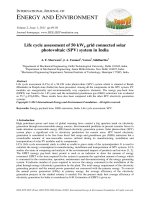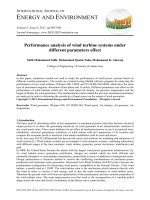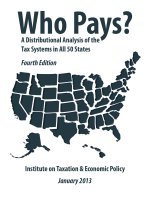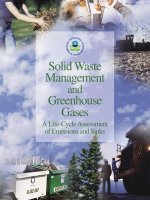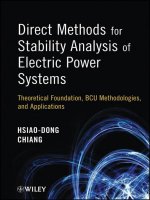Life cycle analysis of electricity generation systems with implications on climate change policy
Bạn đang xem bản rút gọn của tài liệu. Xem và tải ngay bản đầy đủ của tài liệu tại đây (16.39 MB, 296 trang )
LIFECYCLEANALYSISOFELECTRICITYGENERATION
SYSTEMSWITHIMPLICATIONSONCLIMATE
CHANGEPOLICY
NIANJIALIANGVICTOR
NATIONALUNIVERSITYOFSINGAPORE
2014
LIFECYCLEANALYSISOFELECTRICITYGENERATION
SYSTEMSWITHIMPLICATIONSONCLIMATE
CHANGEPOLICY
NIANJIALIANGVICTOR
B.Eng.(Hons.),NUS
ATHESISSUBMITTED
FORTHEDEGREEOFDOCTOROFPHILOSOPHY
DEPARTMENTOFMECHANICALENGINEERING
NATIONALUNIVERSITYOFSINGAPORE
2014
Declaration
I hereby declare that,this thesis
is
my original work and
it
has
been written by
me
in
its entirety.
I have duly acknowledged all the sources
of
information which have been
used in the thesis.
This thesis
has
also
not
been submitted
for
any degree in any university
previously.
Nian Jialiang Victor
3 January
2014
i
Acknowledgement
Iwouldlike togratefullyandsincerely thankmythesissupervisor,Professor
Chou Siaw Kiang for his guidance, understanding, and patience during my
graduatestudiesattheNationalUniversityofSingapore.Hismentorshipwas
paramount in providing a well‐roundedexperience consistent mylong‐term
career goals. He encouraged me to not only grow as an engineer and an
academicresearcher,butalsoasaninstructorandanindependentthinker.I
amgratefulforhisconfidenceinmydevelopmentofmyindividualityandself‐
sufficiencybybeingallowedtoworkwithsuchindependence.Foreverything
you’vedoneforme,ProfessorChou,Ithankyou.Iwouldalsoliketothankthe
Department of Mechanical Engineering, especially all members inmy thesis
committeefortheiradviceinshapingthefocusofmyresearch.
IwouldalsoliketothankDr.JohnBaulyforhisguidanceingettingmygraduate
careerstartedontherightfootandprovidingmegenerouslywithhisexpert
knowledgevaluabletomyresearch.Iamgratefulforhisgeneroussharingof
hisvastexperiencesinnuclearengineering.Despitehisbusyscheduleandthe
long distance between Singapore and Zurich, his valuable comments and
advice had alwaysbeen reaching me
in atimely manner. Working withhim
grantedmewiththe uniqueopportunitytogainawiderbreadthofresearch
experiences.
IwouldliketothanktheEnergyStudiesInstituteforgivingmetheopportunity
toparticipateinimportantresearchprojects.Iwashonouredtobeawarded
with a research
scholarship top‐up from the institute for the project on an
energyeconomymodeloftheSingapore’selectricitysector.
Finally,andmostimportantly,Iwouldliketothankmyfamily,especiallymy
parents,fortheirsupport,encouragement,quietpatienceandunfailinglove.I
am grateful for their faith in me and allowing me to be as ambitious as I
ii
wanted.ItwasundertheirwatchfuleyethatIgainedso much drive and an
abilitytotacklechallengesheadon.
iii
TableofContents
Summary iv
ListofFigures vi
ListofTables viii
ListofAbbreviations ix
ListofSymbols xi
1 Introduction 1
2 LiteratureReview 13
3 DevelopmentoftheMethodology 27
3.1 Genericpowergenerationsystemdefinition 27
3.2 Levelledsystemstructureandassociatedboundaries 40
3.3 KayaIdentityanddecomposition 53
4 CaseStudyonaReferenceLightWaterReactor 107
4.1 Referenceglobaluraniumsupplychain 107
4.2 Uraniumfuelcyclecalculation 109
4.3 ProcessChainAnalysisfortheLWR 116
4.4 Lifecycleenergyandcarbonemissionanalysis 134
4.5 Furtheranalysis 147
5 CaseStudyonFutureSmallMediumReactors 169
5.1 Thestateoffissionpowerreactordevelopment 169
5.2 ReactortechnologyroadmaptowardsGenerationIV 181
5.3 TheprospectsoftheSMRs 190
5.4 Evolutiontowards“SmarterEnergy”future 207
6 Discussions 217
6.1 TechnicalBenefits 217
6.2 PolicyBenefits 221
6.3 Limitations 223
7 ConcludingRemarks 226
References 231
iv
Summary
Given the urgency to mitigate the warming climate caused by excess
anthropogenic carbon emissions, decarbonizing the global energy system
rankedas oneof the toppriorities.In evaluating thealternativelow carbon
technologies,lifecycleanalysis(LCA)emergedstronglyasamodellingtoolfor
supporting the decision making process. An
LCA focusing on energy
consumption and carbon emissions can provide insights on climate change
policy.Overthedecades,twodominant approacheswereestablishedinthe
LCAliterature,namelytheInput‐OutputAnalysis(IOA),andtheProcessChain
Analysis(PCA)approaches.
TheIOAisaneconomicdriventop‐downapproachthat
considersaggregated
flowsbetweeneconomicsectors.ThePCAisabottom‐upa pproachthatuses
engineering and process‐specific data. PCA generally yields more accurate
results, but it is a time consuming exercise. Thus, a PCA exercise is usually
simplified by applying “cut‐off” criteria to exclude less relevant processes,
leadingtowardspotentialunder‐estimationoftheimpact.Ontheotherhand,
theresultsfromIOAaremorecompleteandlesscasedependent,buttheyare
also less precise. There are also transparency issues due to the lack of
granularityattheprocesslevel.
From a quick scan, we detected a
large dispersion on the life cycle carbon
emissionfactorsofelectricitygenerationsystem,nuclearpowerinparticular.
v
Basedonourliteraturereview,therewasalackofstandardizedmethodology
in the PCA approach for benchmarking. In response, we proposed a
methodologytostreamline theformulationofthelifecycleenergysystem.The
methodology,developedbasedonthefirstprinciple,cangivecleardepiction
on the elementary mechanisms of the input‐output interactions across the
systemboundaries.Theresultingsystemboundariescanfacilitatetheuseof
KayaIdentityandthedecompositionconcepttoobjectivelyestablishthe“cut‐
off”criteriaforanLCA‐PCAexercise.
Twocasestudiesweredevelopedwithoneonareferencelargesizereactor
systemandtheotheronaSmallandMediumReactor(SMR)system.Fromthe
case study results, the methodology was capable of estimating with good
confidence the life cycle carbon emission factor of existing electricity
generationsystems.Itwasalsocapableofprojectingthelifecycleenergyinput
andcarbonemissionsoffutureelectricitygenerationtechnologies,suchasan
advanced SMR system. Moreover, the methodology was also capable of
analysing the influence of key design parameters on the life cycle carbon
emissions of the system. These capabilities can provide insights directly
relevantforenergysystemplanningandclimatechangepolicymaking.
vi
ListofFigures
Figure1‐1The“450Scenario”developedbytheIEA 3
Figure1‐2GeneralframeworkofanLCAonfissionpowergeneration 6
Figure1‐3Lifecyclecarbonemissionsoffissionpowergenerationreportedin
theliterature(logarithmplot) 7
Figure2‐1CriteriaontheevaluationofLCAmethodologies 14
Figure3‐1Schematicofaheatengine 28
Figure3‐2Schematicofsteamelectricitygeneration 29
Figure3‐3Schematicofthegenericelectricitygenerationsystem 30
Figure3‐4Genericelectricitygenerationsystemwithrepresentationson
environmentalimpact 31
Figure3‐5Powergenerationandupstreamsystems 32
Figure3‐6Schematicofabroaderfuelfabricationsystem 34
Figure3‐7Extendedenergyinputdefinitionforpowergenerationsystem 35
Figure3‐8Formationoflifecycleelectricitygenerationsystemviasystem
merging 36
Figure3‐9Completerepresentationofthelifecycleelectricitygeneration
system 37
Figure3‐10Genericlifecycleelectricitygenerationsystem 37
Figure3‐11Generic“LCAMainSystem”definitionforelectricitygenerationin
thePCAapproach 38
Figure3‐12Boundariesbetweenthetechnologicalsystemandits
surroundings 45
Figure3‐13Boundariesbetweenthe“LCAMainSystem”andthe“LCASub‐
systems” 45
Figure3‐14Expandedviewoflevelledsystemstructure 49
Figure3‐15DefiningthecarbonemissionstreamswithC
Int
andC
Ext
55
Figure3‐16Simplifiedmulti‐processsystemrepresentation 58
Figure3‐17SchematicfordecomposingatLevel1‐“EnergyInput”side 63
Figure3‐18SchematicfordecomposingatLevel2‐“EnergyInput”side 71
Figure3‐19SchematicfordecomposingatLevel1‐“Non‐EnergyInput”side
82
Figure3‐20SchematicfordecomposingatLevel2‐“Non‐EnergyInput”side
85
Figure4‐1Globaluraniumsupplychainforthecasestudy 109
Figure4‐2Summaryofuraniumfuelcyclecalculationresults 116
Figure4‐3Schematicoftheuraniumminingandmilling“Process” 118
Figure4‐4Schematicofuraniumconversion“Process” 120
Figure4‐5Schematicofuraniumenrichment“Process”(Scenario1) 122
Figure4‐6Schematicofuraniumenrichment“Process”(Scenario2) 123
Figure4‐7Schematicofuraniumenrichment“Process”(Scenario3) 123
Figure4‐8Schematicoffuelfabrication“Process” 126
Figure4‐9Schematicofpowergeneration“Process” 129
Figure4‐10SchematicofSFinterimstorage“Process” 131
Figure4‐11Schematicofspentfueldisposal“Process” 133
vii
Figure4‐12Benchmarkingthecasestudyresultsagainstthemedianof
publishedLCAresults 142
Figure4‐13BenchmarkingthecasestudyresultsforLevel0againstthe
medianofpublishedLCAresults 143
Figure4‐14Benchmarkingthecasestudyresultsagainsttheaverageof
publishedvalues 144
Figure4‐15BenchmarkingthecasestudyresultsforLevel0againstthe
averageofpublishedvalues 145
Figure4‐16Distributionof“ProcessEnergyInput” 149
Figure4‐17Shareof“ProcessEnergyInput” 150
Figure4‐18Distributionofupstream“ProcessEnergyInput” 151
Figure4‐19Distributionof“Process”carbonemissions 153
Figure4‐20Shareof“Process”carbonemissions 154
Figure4‐21Distributionofupstream“Process”carbonemissions 155
Figure4‐22Influenceofuraniumoregradetothelifecyclecarbonemission
factorofthereferenceLWRsystem 158
Figure4‐23Typicalinitialloadingmapforareactorcore 160
Figure4‐24Impactofenrichmentconcentrationtothelifecycleemission
factor 162
Figure4‐25Scenariodependenttrajectoriesofemissionfactors 163
Figure4‐26Influenceof
235
UConcentrationinScenario1 164
Figure4‐27Influenceof
235
UConcentrationinScenario2 166
Figure4‐28Influenceof
235
UConcentrationinScenario3 168
Figure5‐1Graphite“pebble”forPebbleBedReactor 171
Figure5‐2OlkiluotonuclearpowerstationUnit3(EPRunit) 174
Figure5‐3LoviisanuclearpowerstationwithtwounitsofVVER‐440 174
Figure5‐4QinshanCANDUnuclearpowerstation 175
Figure5‐5Shikanuclearpowerstation(BWRandABWR) 176
Figure5‐6Leningradnuclearpowerplant(RMBKandVVERreactors) 177
Figure5‐7Monjunuclearpowerstation(sodiumcooledLMFBR) 179
Figure5‐8TornessAGRpowerstation,Scotland 180
Figure5‐9Roadmapforfissionpowerreactors 183
Figure5‐10Theprospectoffuturereactorlicensing 184
Figure5‐11Benchmarkinglifecyclecarbonemissionfactors 192
Figure5‐12BenchmarkingthelifecyclecarbonemissionfactoroftheSMRin
thetechnologyconservativescenario 195
Figure5‐13BenchmarkingthelifecyclecarbonemissionfactoroftheSMRin
thetechnologyoptimisticscenario 197
Figure5‐14Influenceofuraniumoregradetothelifecyclecarbonemission
factoroftheconceptualizedSMR 199
Figure5‐15LCOEsofalternativepowergenerationtechnologies 201
Figure5‐16Capitalcostsofalternativepowergenerationtechnologies 202
Figure5‐17Capitalcostsofalternativepowergenerationtechnologies
includingSMR 203
Figure5‐18LCOEsofalternativepowergenerationtechnologiesincluding
SMR 204
viii
ListofTables
Table2‐1SummaryofsignificantmilestonesinLCAdevelopment 25
Table4‐1OperatingconditionsofthereferenceLWRsysteminSingapore110
Table4‐2SummaryofSWUcalculation 114
Table4‐3Miningandmilling“Process”inputs 119
Table4‐4Conversion“Process”inputs 121
Table4‐5Enrichment“Process”inputs‐Scenario1 124
Table4‐6Enrichment“Process”inputs‐Scenario2 124
Table4‐7Enrichment“Process”inputs‐Scenario3 125
Table4‐8Fuelfabrication“ProcessEnergyInput”‐Scenario1 127
Table4‐9Fuelfabrication“ProcessEnergyInput”‐Scenario2 127
Table4‐10Fuelfabrication“ProcessEnergyInput”‐Scenario3 127
Table4‐11Fuelfabrication“ProcessNon‐EnergyInput”‐allscenarios 128
Table4‐12Powergeneration“Process”inputs 129
Table4‐13SFinterimstorage“Process”inputs 131
Table4‐14Spentfueldisposal“Process”inputs 133
Table4‐15Carbonemissionfactorsofelectricity 134
Table4‐16Carbonemissionfactorsoffuels 135
Table4‐17Carbonemissionfactorsofpowerplantmaintenanceactivities135
Table4‐18EnergyandcarbonemissionanalysisforScenario1 135
Table4‐19EnergyandcarbonemissionanalysisforScenario2 136
Table4‐20EnergyandcarbonemissionanalysisforScenario3 137
Table4‐21Carbonemissionfactorsof“Non‐EnergyInput” 139
Table4‐22CasestudyresultsforthereferenceLWRsystem 140
Table4‐23Lifecyclecarbonemissionsonfissionpowerreportedglobally.140
Table4‐24Summaryofresultsforenergyandcarbonemissionanalysis 147
Table4‐25Summaryof“ProcessEnergyInput”inphysicalunit 149
Table4‐26Summaryof“ProcessEnergyInput”inpercentage 150
Table4‐27Summaryof“Process”carbonemissionsinphysicalunit 152
Table4‐28Summaryof“Process”carbonemissionsinpercentage 154
Table4‐29Initial
235
Uenrichmentvs.averageassemblyburn‐upforLeibstadt
LWR 161
Table5‐1SummaryofcurrentSMRdesigns 186
Table5‐2SMRoperatingconditions–technologyconservativescenario 193
Table5‐3SummaryofcasestudyresultsfortheconceptualizedSMRinthe
technologyconservativescenario 194
Table5‐4SMRoperatingconditions–technologyoptimisticscenario 196
Table5‐5SummaryofcasestudyresultsfortheconceptualizedSMRinthe
technologyoptimisticscenario 196
Table5‐6OvernightcostandtheLCOEoftheconceptualizedSMRdesign.203
Table5‐7Benchmarkingthekeycharacteristicsofalternativepower
generationtechnologies 211
ix
ListofAbbreviations
ABWR Advancedboilingwaterreactor
AGR Advancedgas‐cooledreactor
AHTR Advancedhightemperaturereactor
ASEAN AssociationofSoutheastAsianNations
BWR Boilingwaterreactor
CANDU CanadaDeuteriumUranium
CCGT Combinedcyclegasturbine
CRIEPI CentralResearchInstituteofElectricPowerIndustry
DEPT Dimensionlessenergypaybacktime
EDF Electricityde
France
EJ Exajoule
EPR EuropeanPressurizedReactor
EPT Energypaybacktime
ESBWR Economicallysimplifiedboilingwaterreactor
FBR Fastbreederreactor
FNR Fastneutronreactor
GCR Gascooledreactor
GDP Grossdomesticproduct
GHG Greenhousegas
GIF GenerationIVInternationalForum
GJ Gigajoule
GFR Gas‐cooledFastReactor
GMR Graphitemoderated
reactor
GWD GigawattDay(typicalunitforuraniumfuelburn‐up)
GWh Gigawatthour
HTR Hightemperaturereactor
HWR Heavywaterreactor
IAEA InternationalAtomicEnergyAgency
IEA InternationalEnergy Agency
IR InferredResources
ISL In‐Situleaching
IPCC IntergovernmentalPanelonClimateChange
LCA Lifecycleanalysis
LCI Lifecycleinventory
LCOE Levellizedcostofelectricity
LFR Lead‐cooledFastReactors
LMFBR Liquidmetalfastbreederreactor
LS‐VHTR Liquidsaltveryhightemperaturereactor
LWR Lightwaterreactor
MSR Moltensaltreactor
MWD MegawattDay(typicalunitforuraniumfuelburn‐up)
MWe Megawattofelectricity
MWh Megawatthour
MWt Megawattofthermalenergy
NEA NuclearEnergyAgency
x
OCGT Opencyclegasturbine
OECD OrganizationforEconomicCooperationandDevelopment
OMR Organicallymoderatedreactor
O&M Operationandmaintenance
PHWR Pressurizedheavywaterreactor
RPV Reactor pressurevessel
PWR Pressurizedwaterreactor
RAR Reasonableassuredresources
RBMK ReaktorBolshoyMoschnostiKanalniy(HighPowerChannel
Reactor)
R&D Researchanddevelopment
SC Supercritical
SCWR Supercriticalwatercooledreactor
SFR Sodiumcooledfastreactor
SMR SmallandMediumReactor
SWU Separativeworkunit
toe Tonneofoilequivalent
TWh Terawatthour
UNFCCC UnitedNationsFrameworkConventiononClimateChange
UNGG UraniumNaturelGraphiteGaz
USC Ultra‐supercritical
U.S.DOE UnitedStatesDepartmentofEnergy
U.S.EIA UnitedStatesEnergyInformationAdministration
U.S.NERAC UnitedStatesNuclearEnergyResearchAdvisoryCommittee
U.S.NRC UnitedStatesNuclearRegulatoryCommission
VHTR Veryhightemperaturereactor
VVER Vodo‐VodyanoiEnergeticheskyReactor
WNA WorldNuclearAssociation
WWER Water‐WaterEnergeticReactor
xi
ListofSymbols
:then
th
processofthe“LCASub‐system”onthe“EnergyInput”
side
:“product”of“Process”
:then
th
processofthe“LCASub‐system”onthe“Non‐Energy
Input”side
:“product”of“Process”
:carbon(GHG)emissions
:carbonemissionsduetoEnergyInput
:extrinsicemissionof“Process”input
:carbonemissionsfromfuelfabrication
:intrinsicemissionof“Process”input
:carbonemissionsfromthe“Fuel”
:lifecyclecarbonemissionsfromthe“LCAMainSystem”
:carbonemissionsfromthemining
:carbonemissionsdueto“Non‐EnergyInput”
:carbonemissionsfromthepowergeneration
:carbonemissionsofasystem
:thecarboncostatyear“”
:thedecommissioningcostatyear“”
:energyintensityofproductfromalifecycle“Process”
:theamountofenergyorheatreleasedfromfuel(primary
energy)
:energyinputtothefuelfabricationsystem
:energylossofthefuelfabricationsystem
:energyinputtotheminingsystem
:energylossoftheminingsystem
,,
:“EnergyInput”toeach“Process”ofthe“LCAMainSystem”or
“Sub‐system”
:“EnergyInput”toasystem
:energylossesofasystem
:energyoutputfromasystem
:energyinputtothefuelfabricationprocess
:energyinputtotheminingsystem
:energylossoftheminingsystem
:energyinputtothepowergenerationprocess
:electricitygeneratedatyear“”
:fragmentsfromthefissionprocess
:thesubstancerequiredtoproducethermalenergy
:thefuelcostattime(year)“”
:heatvalueofreactorfuel
:theinvestmentcostattime(year)“”
:conversionfactorforspentfuelassembly(kgperunitofspent
fuel)
xii
:massofdifferentformsoffuel(denotedbyeachrespective
subscript)
:feedmass
:massofwastes(residues)fromthefuelfabricationprocess
:massoffuelforproducingthermalenergy
:productmass
:wastes(residues)fromthepowergenerationprocess(quasi‐
heat‐enginedefinition)
:tailmass
:GHGemissionsfrompowergeneration
:wastes(residues)producedfrompowergeneration
:wastes(residue)factor(genericdefinition)
:“Non‐EnergyInput”(e.g.powerplantfacilities,pumps,
materials,etc.)topowergeneration
,,
:“Non‐EnergyInput”toeach“Process”ofthe“LCAMainSystem”
or“Sub‐system”
:intensityof“Non‐EnergyInput”consumptionof“product”ina
“Process”
:intensityof“Non‐EnergyInput”requiredto“produce”
by
type
&
:theoperationsandmaintenancecostattime(year)“”
:generatingcapacityofthemodelplant
:“product”ofthen
th
“Process”ofthe“LCAMainSystem”
:themagnitudeofheattransferbetweenthecyclicdeviceand
thehigh‐temperaturemediumattemperature
:themagnitudeofheattransferbetweenthecyclicdeviceand
thelow‐temperaturemediumattemperature
:thermalenergy
:discountrate
:separativeworkfunction
:lifetimeofthemodelplant
:temperatureofthehightemperaturemedium
:temperatureofthelowtemperaturemedium
:time(year)
:valuefunctionbasedontheenrichmentvalues
:numberofneutrons
,
:networkoutput
:protonnumberoftheatomicfragmentafterfissionprocess
:feedassay
:productassay
:tailassay
:
235
Uenrichmentconcentration
:natural
235
Uconcentration
:uraniumoregrade
:feed‐to‐productratio
:energypaybacktime
:thermalefficiencyofthepowergenerationtechnology
xiii
:systemenergyefficiency
:dimensionlessenergypaybacktime
:loadingfactor
1
1 Introduction
Global warming caused by anthropogenic carbon emissions has received
increasingattentionoverthedecades[1].Thereisastrongscientific consensus
thatcontinuedrisingtrendofglobalwarmingwillleadtocatastrophicclimate
change, threatening life of millions [2]. According to the ADB [3], climate
changewillhavesevereadverse
effectsonthesustainabledevelopmentand
poverty eradication efforts globally and particularly to the Southeast Asian
region. First, a large population (about 563 million people) lives along the
coastlines,measuring about 173,251 kilometres long. Thesepopulationsare
highly vulnerable to sea level rises. Second, even though rapid economic
growthandstructural
transformationbroughtmillionsoutofextremepoverty,
therewerestillabout93million(18.8%)livinginextremepovertyasof2005.
Third, agriculture accounted for about 43% of the total employment in
Southeast Asia and contributed about 11% GDP in 2006. The increase in
extremeweatherevents(suchasdroughts,floods,andtropicalcyclones,and
warming),andforestfiresduetoclimatechangeseriouslythreatentheexport
of agricultural produce. Lastly, increases in frequency and intensity of heat
waves,droughts,floods,andtropicalcycloneswillleadtomorefrequentand
extensivedamagetopropertiesandhumanlives.Itisthereforeimportantto
takeonurgentactionindecarbonizingourenergysystems.
One of the typical approaches in identifying the means of reducing carbon
emissions is energy systems modelling. Under the broad family of energy
2
systemmodellingframeworks,thereisalargepoolofmethodologiesandtools
focusingontheassessmentofenvironmentalimpacts,reportedbyFinnveden
[4]. By examining the pool of methodologies, life cycle analysis (LCA) is the
most relevant methodology for quantifying major potential environmental
impacts related to the product or service. In this case, the environmental
impactsrefertocarbonemissions,whichcauseglobalwarming.
TheinterestinLCAexperiencedrapidgrowthsincetheearly1990s.Initially,
LCAswereappliedforproducts[5,6]asadecisionsupporttoolforselection
among different alternatives. In the early development, LCA received both
highexpectationandvariedcriticisms,asseeninUdodeHaes[7],Ayres[8],
Ehrenfeld[9],KrozerandViz[10],andFinnveden[11].Theseexpectationsand
criticisms stimulated strong development efforts globally. Over the years,
international standards, ISO14040 [12] on principles and framework, and
ISO14044 [13] on requirements and guidelines were established. These
standardswerecomplementedbyoperationalguides,suchasGuinée[14],and
textbooks,suchasWenzelandothers[15],andBaumannandTillman[16].
Over the decades, LCA has been progressively applied to energy producing
systems, especially power generation [17]. From 1973 to 2011, the global
energy production increased from 6,129 TWh to 22,202 TWh at an average
annualgrowthrateof3.5%[18].In2010,powergenerationwasaccountable
for 41% of carbon emissions with 67.8% of the world electricity production
from fossil fired power plants [19]. Thus, it is important to identify suitable
3
powergenerationsystemstoreducethe carbon emissions by means ofLCA
studies.Giventhestrategicimportanceoffissionpowerinaddressingenergy
securityandreducingcarbonemissionsasdiscussedin[20,21],itbecameone
ofthepopulartargetsforLCAstudies[22].Inthe“450Scenario”developedby
the International Energy Agency (IEA), fission power was expected to
contribute to 6% of the carbon emissions reductions from the Business‐As‐
Usual(BAU)scenario(Figure1‐1drawnbasedontheinformationfrom[23]).
Figure1‐1The“450Scenario”developedbytheIEA
According to Turconi [17], therewere broadlyfour phasesin conductingan
LCA:1)goalandscopedefinition,2)inventoryanalysis,3)impactassessment,
and4)interpretation.Althoughtherewasaregulatoryframeworkdefinedin
ISO14040andISO14044,theguidelinesprovidedinthecurrentISOstandards
for conducting an LCA study allowed for flexibility in interpreting key
methodologicalissues[24].Suchflexibilityhasledtosubjectiveapproachesin
the formulation of an LCA methodology, which may produce incompatible
resultswithotherLCAstudiesofidenticalgoalsandscope.Intheabsenceofa
4
standardized approach, it was difficult to benchmark the LCA results from
differentmethodologies.
Ingeneral,therearebroadlytwoapproachesintheLCAliterature,theProcess
ChainAnalysis(PCA)andtheInput‐OutputAnalysis(IOA).PCAisabottom‐up
approachthatusesengineeringandprocess‐specificdata.Ideally,thesedata
areobtaineddirectlyfromtheactualplantsinthesupplychain.PCAgenerally
yields more accurate results, but it is a time consuming exercise [25]. Very
often,aPCAexerciseissimplifiedbyapplying“cut‐off”criteriatoexcludeless
relevantprocesses,leadingtowardspotentialunder‐estimationoftheimpact
[26]. Ontheother hand, theIOA is an economicdriventop‐down approach
thatconsidersaggregatedflowsbetweeneconomicsectors.Itisoftenusedfor
trackingtheembodiedenergyorembodiedcarbonemissionsintrade[27,28]
withtheabilitytoconsiderthefeedbackeffectsin amulti‐regionalsetting[29].
Compared with PCA, the results from IOAare more complete and less case
dependent, but they are also less precise [30]. There are also transparency
issuesduetothelackofgranularityattheprocesslevel.
Intheliterature,therewerealsodevelopmentsonthehybridapproachesby
linkinguptheIOAandPCA,suchasBullard[31],Wilting[32],Treloar[33],Suh
[34].However,therewerenotmanystudiesusingtheseapproachesavailable
intheliterature[17].Wi edmann andothers[35]usedtwohybridapproaches
aswellasthePCAapproachtoestimatethelifecycle
carbonemissionsofwind
powerintheUK.Althoughthefinalresultsofthetwohybridapproacheswere
5
similar,therewerestrongvariationsintherelativecontributionsoflifecycle
inventory(LCI).Sincetheissueswerecentredoninputsattheprocesslevel,it
signalledtheneedtofurtherenhancethePCAmethodology.
ForboththeIOAandPCAapproaches,itisnecessaryforanLCAstudytoselect
an appropriate set of LCIs to reflect the local conditions and the temporal
scope of the study [17]. The selection of LCI is closely dependent on the
formulation of the life cycle system. In the case of a PCA, the granularity
requirementfortheLCIdatasetishigh
andcanbedifficulttoobtain.However,
thesamesetofLCIscanleadtoconsiderablydifferentresultsintheabsence
ofaproperlyformulatedLCAmethodologyinthePCAapproach.Thecauseof
suchvariationwasfoundtoberelatedtothereliabilityofthemethodological
developmentinthePCA
approach.
Usingfissionpowerasanillustration,ageneralframeworkforanLCAstudyin
thePCAapproachcanbeoutlinedasschematizedinFigure1‐2.Basedonthis
approach,severalLCAmethodologiesonfissionpower,suchas[36‐47]were
developed with corresponding life cycle carbon emission factors reported.
However,thereisalackofastandardizedmethodologyinthePCAapproach
for benchmarking the current LCA results on fission power. Without a
standardized methodology, it is also difficult to benchmark the life cycle
carbonemissionsofalternativepowergenerationsystems.
6
Figure1‐2GeneralframeworkofanLCAonfissionpowergeneration
Basedonourassessmentonthecredibilityandreputation,wehavecarefully
selectedalistofmorethan50LCAstudiesinthePCAapproach.Thesestudies
constitute more than 90 sample points for the LCA results. Based on our
observation,the reported values of thelifecycle carbon emissionfactorsof
fission power varied by more than a factor of 100 (Figure 1‐3). Such a
magnitudeof dispersion are hardlyplausible.Itseemstosuggest that there
arereliabilityissueswiththecurrentmethodologies.Thus,itsuggeststheneed
tocarefullyinvestigatetheissuesassociatedwiththecurrentLCAstudies.In
brief,wefoundthattherewerereliabilityissuesfromboththemethodological
developmentandLCIselectionaspects.
7
Figure1‐3Lifecyclecarbonemissionsoffissionpowergenerationreported
intheliterature(logarithmplot)
In turn, these reliability issues may lead negative consequences as many
globallyrecognizedstudiesarerelyingontheLCAresultsfromtheliterature.
Pacala and Socolow [48] developed a methodology under which replacing
conventionalfossilfuelledtechnologieswithnewandcleantechnologiescould
formwedgestohelpstabilizetheatmosphericCO
2
concentration.TheIEA[23]
referenced LCA results on power generation for the development the 450
Scenario. In the discussion on future emission scenarios, the IPCC [49]
referenced LCA results from the literature for benchmarking the life cycle
8
carbon emissions from alternative power generation technologies with key
policyrecommendations.TheLCAresultswerealsousedbytheconsultantsat
Mckinsey for the development of a global Marginal Abatement Cost Curve
(MACC)[50,51].Attheregionallevel,theADBreferencedLCAresultsinthe
discussionaboutclimatechangeinSoutheastAsia[3].Atthecountrylevel,the
U.S. Energy Information Administration (EIA) referenced LCA results for the
agency’sAnnualEnergyOutlookseries [52]. Alloftheseauthoritative works
maybecomeunreliablewiththeuseofunreliableLCAresults.Assuch,itmay
leadtotheill‐informed
decisionmaking,whichcouldresultinadverseeffects
indecarbonizingtheenergysystems.
To understand the root cause of the issues with the current LCA
methodologies, we employ a scorecard me thod (explained in Appendix A),
developed by Nian and others [53]. This method allows for a systematic
evaluationonthekey
aspectsofanLCAmethodologyrelatedtoestimatingthe
life cycle carbon emissions of energy systems (explained in Chapter 2). Our
findings suggest that the cause of the issues are rooted primarily from the
system boundary definition. The definition of system boundaries originated
fromthedevelopmentofacradle‐to‐gravesystemaswellastheinput‐output
definitions.Thedefinitionsforalifecyclesystem,itsinput‐outputinteractions,
and boundary selections are fundamental to an LCA methodology on
estimatingcarbonemissions.Thus,thereliabilityissuesneedtobeaddressed
fundamentally.
9
TherewerefourotherissueswiththecurrentLCAmethodologies on power
generationintheliterature.Firstofall,noneoftheexistingLCAmethodologies
were capable of analysing “design” related issues. These “design” related
issues include projecting the life cycle carbon emissions of future and/or
advancedenergysystems,andtheinfluenceonthelifecyclecarbonemissions
from the change in de sign parameters (e.g. reactor size, enrichment
concentration, and uranium ore grade). Indicators derived from these
capabilities are very important for climate change policymaking. Secondly,
therewasnostandardizedLCAmethodologyeventhoughtheywerebasedon
asimilarframework.Inotherwords,thecurrentmethodologieswereusually
case specific. An LCA methodology for solar PV power generation system
cannotbeusedonafissionpowergenerationsystemwithoutre‐definingthe
entirelifecyclesystem.Thirdly,there wasalackofgenericrepresentationon
theenergysystems.AlifecyclesystemdefinedforsolarPVcannotbeusedto
representahybriddiesel‐backedsolarPVsystem.Theseproblemscreateda
barrier for establishing a common platform for repeatability and
benchmarking.
Inviewoftheabove discussion,the objectivesofthisdissertationare:(i)to
developagenericmethodologyforanalysingcarbonemissionsfromelectricity
generation systems usingthe LCA‐PCA approach;(ii) to establishthe cut‐off
criteria for an LCA‐PCAbyusing the genericmethodologytogether with the
concept of Kaya Identity and decomposition; (iii) to apply the generic
methodologytodeterminethelifecyclecarbonemissionfactor(measuredin

